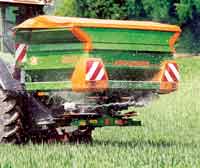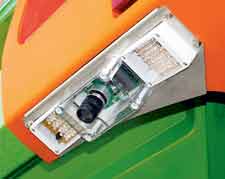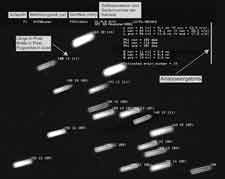Amazone’s camera system helps lower fertiliser waste

It is estimated that across Europe the amount of fertiliser applied is about twice that needed for crop production. That means somewhere there is some serious wastage.
A group of French and Belgian scientists looking into techniques to improve the accuracy of application, believes much of this wastage is down to inconsistency in the material spread.
They are convinced the only way to overcome this is to develop some sophisticated spreader technology capable of adjusting to variations in blend consistency.
The first manufacturer to take a step down this route was German firm Amazone, which showed off a prototype camera system for its spreaders at 2007’s Agritechnica show in Hanover.
Almost two years on things are progressing, although the Argus set-up is still a way off becoming a commercial reality.
How does it work?
A camera looking down at the fan of material leaving the spreader discs provides a constant video stream and passes it on to the control box.
The computer measures the width, length and the angle of trajectory of each individual granule or prill to get a picture of its speed and position and, therefore, where it is likely to end up.
It compares those characteristics with a bank of stored data to work out whether it is achieving an even spread to the desired width.
It is then able to adjust disc speed to match the physical properties of the product and, therefore, maintain an even spread pattern irrespective of the quality of the fertiliser.
For example, if a coarse, rough product is being used, it has a tendency to be thrown wider and needs to be reined in. Reducing disc speed alters the ejection point off the edge of the disc and brings it into line with the desired spread width.
Left: Amazone’s Argus system uses a digital camera and two banks of infra-red LEDs to track the spread of fertiliser as it leaves the spreader discs. Right: The image the camera sees – the speed, size and direction of each individual prill is monitored and the computer adjusts disc speed accordingly to maintain an even spread


What hardware is required?
A single digital camera is mounted above the right-hand spreader disc and is flanked by a pair of LED lamps. These emit pulsed infrared light to eliminate the effects of varying levels of sunlight.
The camera sends a signal to Amazone’s standard Amatron+ in-cab computer, which then does all the clever stuff.
The only requirement of the spreader is that it has hydraulically-driven discs to allow spread width to be varied independently of engine rpm.
To see an animation of the system click here
What are the advantages?
Fertiliser is always distributed evenly across the correct working width meaning that the crop grows and ripens evenly and that the final product is as uniform as possible.
Accuracy is vastly improved, so wastage is minimised and cheaper products can be used with confidence, hopefully leading to cost savings.
Set-up is easy – calibration and tray tests become unnecessary, as do product spread charts.
By adopting hydraulic disc drive, operators get the added benefit of Amazone’s clever headland shutoff system, which slows disc speed and flow rate as the spreader approaches angled field margins, much like boom section shutoff on sprayers. This can be done manually or automatically with a GPS signal.
Hydraulic drive also means the tractor doesn’t have to run flat-out to achieve the correct disc speed. Most have enough oil-flow to meet the 55 litres/min minimum at tickover, so there is the chance for significant fuel savings and disc speed can be maintained independently of engine rpm.
When will it be available?
No date has been set for Argus’ commercial launch and, as with all things electronic, there is much software development to be done. But the project continues to make the theory a practical reality.
Quality not quantity The past few years have seen dramatic variations in fertiliser quality says Amazone’s Simon Brown. With an ever-widening range of products available, it makes accurate and even spreading a tough task.
“It’s ironic that as we’ve seen fertiliser prices quadruple, we’ve seen product quality plummet,” he says.
“I’ve never known a year like it. It’s really difficult to get a uniform spread and, of course, it’s always the machine that gets blamed.”
The headache comes when none of the three key criteria – granule size, bulk density (or granule weight) and surface finish – matches the original specification.
“On a typical 1000-acre arable unit they will be putting on up to £200,000 in N, P and K, so it really pays to spend out on a decent spreader and take the time to calibrate.
“When we get the Argus system up and running we’ll be taking the hassle out of the job, so there’ll be no calibration required and no wastage.”

